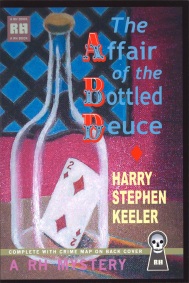





Emboldened by the experience of The Rynox Mystery (1930) by Philip MacDonald from last week — an author with whom I started poorly and have come to really enjoy — I turn to Harry Stephen Keeler. The only other Keeler I’ve read to date was…fine, and I’ve been admittedly reluctant to begin this despite its locked room murder being why I bought it in the first place. The superb introduction from Francis M. Nevins explains how and why this was unpublished in Keeler’s lifetime and only came into public being through Keelerite Fender Tucker’s Ramble House imprint in 2005. As you gather from my rating, I’m of the opinion the public would’ve coped perfectly fine without it.
The setup itself is very good indeed. It reads like the sort of low-rent pulp Nevins makes it clear was selling in droves at the time, and Keeler had been unpublished for no little while and so was arguably consciously providing what publishers wanted. We open with a phone call to the police, a landlord reporting that the tenant who lives on the floor above him has shot himself in his locked apartment. Through a crack at the side of the door the man’s body can clearly be seen, and a bolt on the inside of the door and padlocked mesh on the insides of the windows preclude an exit by anyone else who may’ve been present. So far, so classic.
And so ‘Lousy’ Lou Ousely and Homer ‘Butterball’ Tomaroy — your pugnacious pulp cops of yore, double-act griping a speciality — are dispatched, break down the door, and find the dead man complete with gun in hand and the eponymous two of diamonds sealed up in a glass bottle. A possible solution for the murder is posited, and we get occasional glimpses of how great a writer Keeler could probably be at times:
Lou looked down at the body seated at the table. In but a few moments — vital moments for somebody right now, perhaps — while they had talked, talked, talked countless words of speculation, a “suicide” who had “suicided” because of receipt of a bottled deuce in the mails — had become a murder victim, representing merely a staged “suicide”. And the minutes they’d talked around here, and speculated around here, had been perhaps vitally needed minutes — for the killer.
At least it’s not only me who has some duff reads this week. I’m surprised you braved another Keeler. One is surely more than enough for anyone… Keeler certainly tests the wit of a blogger’s synopsis writing skills, so I’m impressed how you’ve normalised what I imagine is a wild and far ranging story. Hope you’re next read is a better one.
LikeLike
It’s actually pretty focused, apart from his tendency to write dialogue that just veers and wanders and glides about all over the place. Anyway, not one I can recommend anyone trouble themselves with. You certainly were in good company with disappointing reads here…!
LikeLike
The wax gun is a bloody great idea! Shame it didn’t come off. How is the solution to the locked room?
LikeLike
The solution is the reworking of an old one — perfectly fine, semi-prepared for, but it does also come a bit out of nowhere. had it any points of interest, I would’ve mentioned the fact, worry not!
LikeLiked by 1 person
Yet again, in the process of ripping on a book, you somehow make me desperately want to read it…
LikeLike
Well, I might have a copy going spare 🙂
LikeLike
Am I right in thinking Keeler is a personal favourite of Ramble House and Fender Tucker? Everyone else seems much more lukewarm though. In fact, I can’t recall having read a single positive review of any of Keeler’s works!
Thanks for the review and for the warning. 😅
LikeLike
I think it would take some explaining were Fender Tucker not a great fan of Keeler — why else would you go to the trouble of republishing the man’s entire catalogue including tracking down all the unpublished works? That’s a complicated tax dodge if you’re not a fan… 😀
LikeLike
Good job, JJ. You just killed the only chance I had to sample one of Keeler’s mystery novels. This was the only one I was prepared to try, but you just saved me the trouble. So, thanks, I guess.
By the way, Keeler strikes me as a bottom of the barrel writer who should only be read when you’re scraping the bottom.
LikeLike
I’m aware the man wrote, like, 85 books and I’m willing to trust that I’ve not sampled the best two. And this was unpublished, so maybe not indicative of his best work…
Still, for the curious,the next one I might try is the wonderful-sounding The Case of the Transparent Nude:
A woman’s body disappears while taking a steam bath. Only her head and toes, sticking out of the steam cabinet, remain.
Sure, the misuse of the wax gun here implies that Keeler might not be the strongest on puzzle plotting, but it at least sounds like it could have promise.
LikeLike
That sounds more gruesome than puzzling…! 😯
LikeLike